
24 Results



This course examines the chemical and physical properties of the cell and its building blocks, with special emphasis on the structures of proteins and principles of catalysis, as well as the chemistry of organic / inorganic cofactors required for chemical transformations within the cell. Topics encompass the basic principles of metabolism and regulation in pathways, including glycolysis, gluconeogenesis, fatty acid synthesis / degradation, pentose phosphate pathway, Krebs cycle and oxidative phosphorylation.
Course Format
This OCW Scholar course, designed for independent study, is closely modeled on the course taught on the MIT campus. The on-campus course has two types of class sessions: Lectures and recitations. The lectures meet three times each week and recitations meet once a week. In recitations, an instructor or Teaching Assistant elaborates on concepts presented in lecture, working through new examples with student participation, and answers questions.
MIT students who take the corresponding residential class typically report an average of 10–15 hours spent each week, including lectures, recitations, readings, homework, and exams. All students are encouraged to supplement the textbooks and readings with their own research.
The Scholar course has three major learning units, called Modules. Each module has been divided into a sequence of lecture sessions that include:
Textbook Readings
Lecture Notes or Storyboards
A video by Professor JoAnne Stubbe or Professor John Essigmann
Problem Sets and solutions
To help guide your learning, each of these problem sets are accompanied by Problem Solving Videos where Dr. Bogdan Fedeles solves one of the problems from the set.
- Subject:
- Biology
- Life Science
- Physical Science
- Material Type:
- Full Course
- Provider:
- MIT
- Provider Set:
- MIT OpenCourseWare
- Author:
- Essigmann, John
- Fedeles, Bogdan
- Stubbe, Joanne
- Date Added:
- 09/01/2013

Biology is designed for multi-semester biology courses for science majors. It is grounded on an evolutionary basis and includes exciting features that highlight careers in the biological sciences and everyday applications of the concepts at hand. To meet the needs of today’s instructors and students, some content has been strategically condensed while maintaining the overall scope and coverage of traditional texts for this course. Instructors can customize the book, adapting it to the approach that works best in their classroom. Biology also includes an innovative art program that incorporates critical thinking and clicker questions to help students understand—and apply—key concepts.
- Subject:
- Biology
- Life Science
- Material Type:
- Full Course
- Provider:
- Rice University
- Provider Set:
- OpenStax College
- Date Added:
- 08/22/2012
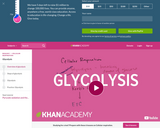
This 13-minute video lesson provides an overview of glycolysis. [Biology playlist: Lesson 24 of 71].
- Subject:
- Biology
- Life Science
- Material Type:
- Lecture
- Provider:
- Khan Academy
- Provider Set:
- Khan Academy
- Author:
- Salman Khan
- Date Added:
- 05/18/2012
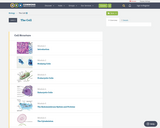
- Subject:
- Biology
- Life Science
- Material Type:
- Unit of Study
- Provider:
- Rice University
- Provider Set:
- OpenStax College

By the end of this section, you will be able to:Discuss the ways in which carbohydrate metabolic pathways, glycolysis, and the citric acid cycle interrelate with protein and lipid metabolic pathwaysExplain why metabolic pathways are not considered closed systems
- Subject:
- Applied Science
- Biology
- Life Science
- Material Type:
- Module
- Date Added:
- 07/10/2017

By the end of this section, you will be able to:Describe the overall result in terms of molecules produced in the breakdown of glucose by glycolysisCompare the output of glycolysis in terms of ATP molecules and NADH molecules produced
- Subject:
- Applied Science
- Biology
- Life Science
- Material Type:
- Module
- Date Added:
- 07/10/2017

By the end of this section, you will be able to:Describe the overall result in terms of molecules produced in the breakdown of glucose by glycolysisCompare the output of glycolysis in terms of ATP molecules and NADH molecules produced
- Subject:
- Applied Science
- Biology
- Life Science
- Material Type:
- Module
- Author:
- Tina B. Jones
- Date Added:
- 08/16/2019

- Subject:
- Applied Science
- Biology
- Life Science
- Material Type:
- Module
- Author:
- Tina B. Jones
- Date Added:
- 08/16/2019

- Subject:
- Applied Science
- Biology
- Life Science
- Material Type:
- Module
- Date Added:
- 07/10/2017
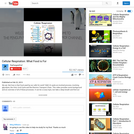
Video tutorial for cellular respiration: overview, glycolysis, citric acid cycle and electron transport chain.
- Subject:
- Life Science
- Material Type:
- Lecture
- Provider:
- The Penguin Prof
- Author:
- The Penguin Prof
- Date Added:
- 10/11/2013
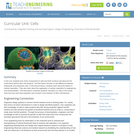
In this unit, students look at the components of cells and their functions and discover the controversy behind stem cell research. The first lesson focuses on the difference between prokaryotic and eukaryotic cells. In the second lesson, students learn about the basics of cellular respiration. They also learn about the application of cellular respiration to engineering and bioremediation. The third lesson continues students' education on cells in the human body and how (and why) engineers are involved in the research of stem cell behavior.
- Subject:
- Applied Science
- Biology
- Engineering
- Life Science
- Material Type:
- Full Course
- Provider:
- TeachEngineering
- Provider Set:
- TeachEngineering
- Date Added:
- 10/14/2015

Cellular Respiration Text, Diagrams, Assessments, and Link to Standards
- Subject:
- Life Science
- Material Type:
- Activity/Lab
- Lesson Plan
- Provider:
- Exploring Nature
- Date Added:
- 11/04/2016
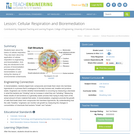
In this lesson, students learn about the basics of cellular respiration. They also learn about the application of cellular respiration to engineering and bioremediation. And, students are introduced to the process of bioremediation and several examples of how bioremediation is used during the cleanup of environmental contaminants.
- Subject:
- Applied Science
- Biology
- Engineering
- Life Science
- Material Type:
- Activity/Lab
- Lesson Plan
- Provider:
- TeachEngineering
- Provider Set:
- TeachEngineering
- Author:
- Janet Yowell
- Kaelin Cawley
- Malinda Schaefer Zarske
- Date Added:
- 09/18/2014

This illustration depicts the first two stages of aerobic respiration: glycolysis and the citric acid cycle.
- Subject:
- Anatomy/Physiology
- Biology
- Botany
- Ecology
- Nutrition
- Material Type:
- Diagram/Illustration
- Author:
- Eunice Laurent
- Date Added:
- 06/10/2022

This illustration depicts the 10 stages of glycolysis.
- Subject:
- Anatomy/Physiology
- Biology
- Botany
- Ecology
- Nutrition
- Material Type:
- Diagram/Illustration
- Author:
- Eunice Laurent
- Date Added:
- 06/10/2022

This resource is a video abstract of a research paper created by Research Square on behalf of its authors. It provides a synopsis that's easy to understand, and can be used to introduce the topics it covers to students, researchers, and the general public. The video's transcript is also provided in full, with a portion provided below for preview:
"Gallbladder cancer (GBC) is becoming increasingly common, especially in American Indian and Southeast Asian populations. Early GBC can be successfully removed with surgery, but advanced GBC has a poor prognosis . and the existing treatments have many side effects. To explore better therapies, researchers recently investigated the anti-GBC effects of penfluridol, an antipsychotic drug with anticancer activity. In vitro, penfluridol (PF) strongly inhibited the replication and invasion of three GBC cell lines, confirming its anti-GBC potential, but it also dramatically increased glucose consumption via glycolysis, which is a hallmark of cancer. Specifically, penfluridol activated the AMPK/PFKFB3 glycolysis pathway. However, inhibiting glycolysis, particularly the AMPK/PFKFB3 pathway (with Compound C, CC) solved this problem enhancing penfluridol’s GBC-killing effects. The same synergistic effects were observed in mouse tumor models in vivo..."
The rest of the transcript, along with a link to the research itself, is available on the resource itself.
- Subject:
- Biology
- Life Science
- Material Type:
- Diagram/Illustration
- Reading
- Provider:
- Research Square
- Provider Set:
- Video Bytes
- Date Added:
- 04/14/2023

This resource is a video abstract of a research paper created by Research Square on behalf of its authors. It provides a synopsis that's easy to understand, and can be used to introduce the topics it covers to students, researchers, and the general public. The video's transcript is also provided in full, with a portion provided below for preview:
"Cancer involves the reprogramming of the body’s cells to allow them to grow, divide, and travel throughout the body. One of the processes involved – metabolic reprogramming – allows cells to use new energy sources for fuel, switching from oxidative phosphorylation to glycolysis. and enabling tumor cells to grow uncontrolled. A recent study evaluated the involvement of the tumor suppressor gene PTEN in metabolic reprogramming. Researchers compared cancerous and noncancerous liver tissue from 128 patients with hepatocellular carcinoma. They found that in cancerous liver tissue, PTEN had a reciprocal relationship with another protein, PI3K. PTEN was downregulated in HCC tissues, and its loss predicted a poor prognosis. Overexpressing PTEN blocked the switch to glycolysis, while elevated PI3K expression was observed in HCC tissues and was inhibited by PTEN overexpression..."
The rest of the transcript, along with a link to the research itself, is available on the resource itself.
- Subject:
- Biology
- Life Science
- Material Type:
- Diagram/Illustration
- Reading
- Provider:
- Research Square
- Provider Set:
- Video Bytes
- Date Added:
- 11/11/2020

This resource is a video abstract of a research paper created by Research Square on behalf of its authors. It provides a synopsis that's easy to understand, and can be used to introduce the topics it covers to students, researchers, and the general public. The video's transcript is also provided in full, with a portion provided below for preview:
"Alzheimer’s disease is the sixth leading cause of death and one of the most prevalent forms of dementia, affecting over 50 million people worldwide. Unfortunately, the molecular signaling pathways underlying neurodegeneration in Alzheimer’s disease are not clearly understood. A recent study identified a link between two physiological phenomena that are affected in Alzheimer's disease: disrupted calcium signaling, which is associated with memory loss and cognitive dysfunction; and increased iron accumulation, which results in neurotoxicity in the brain. Using genetically modified human cell lines and mice, the researchers studied the mechanistic connections between calcium signaling and iron transport. They found that calcium (Ca²⁺) signaling through CAMKK2 and CAMK4 proteins had direct effects on transferrin protein-mediated iron transport..."
The rest of the transcript, along with a link to the research itself, is available on the resource itself.
- Subject:
- Biology
- Life Science
- Material Type:
- Diagram/Illustration
- Reading
- Provider:
- Research Square
- Provider Set:
- Video Bytes
- Date Added:
- 10/29/2020